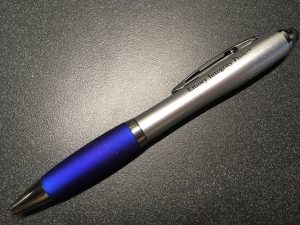
The overview of the pen. Several features suggest that it is a promotional product.
I identified my object as a promotional ball-point pen. It is 13 centimeters (5.7 inches) in length and 1 centimeter (0.39 inch) in width. Its body is comprised of silver plastic with a blue front tube made of rubber. The pen-point can be pushed out by rotating the tube. Contrary to usual ball-point pens, a stylus for touch screen devices is equipped on the end of the pen. A logo “Emory Integrity Project” is printed on the upper barrel, suggesting the identity of this pen as a promotional product for Emory Integrity Project.
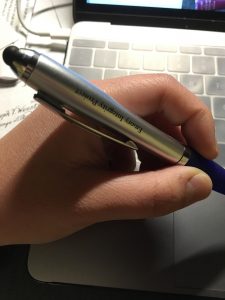
I held it with my left hand. It is clear that the logo is inverted. Thus it will not be an effective advertisement for left-handers.
The pen is smooth and has a fluid shape, giving me a nice feeling when I was holding it. The logo is always present in sight, so it constantly reminded me of the project name. However, I interestingly noticed that the pen does not cater to left-handers. A left-hander can only see the inverted version of the logo when using the pen. This might tell me something about the preconceived ideas of the manufacturers and might even raise more serious questions regarding stereotypes.
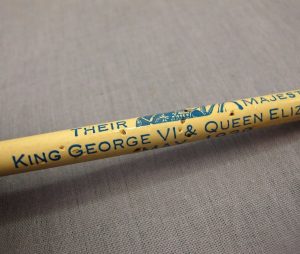
This is a prototype of promotional stationery – a pencil welcoming King George VI and Queen Elizabeth.
This is an early prototype of promotional stationery. It is a pencil commemorating the visit of King George VI to Canada. Though it was not used in the business field, people in the 19th and 20th century had already recognized that pencils and pens could be effective advertising products.
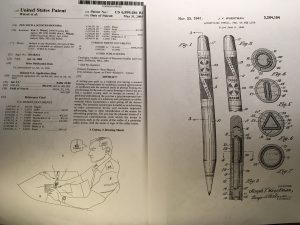
Patented documents of designs of promotional pens
In order to further understand how promotional ball-point pens work, I searched for some patented designs of such pens. These are the two designs that I consider the most interesting. The first one proposed an enamel covering the pen, sending out nice smells when one uses the pen. The other one featured two sliding bars that slide in a crossing fashion, each time combining the brand name on the bar with different slogans.
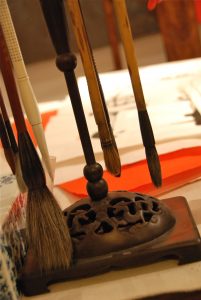
Brush Pens for Chinese Calligraphy. Different types of brushes are for different types of calligraphy.
To show how pens indicate the owner’s identity, I focused on brush pens for Chinese calligraphy. In China, brush pens are a sign of literacy and professionalism, and reflect the education level of the owner. The ball-point pen I received is also a symbol of people in their field. It serves those who can read and write, and those who possess technological devices such as smart phones, tablets etc. From these signs I can thus predict the identity of its owner, presumably a student, a client or a teacher.